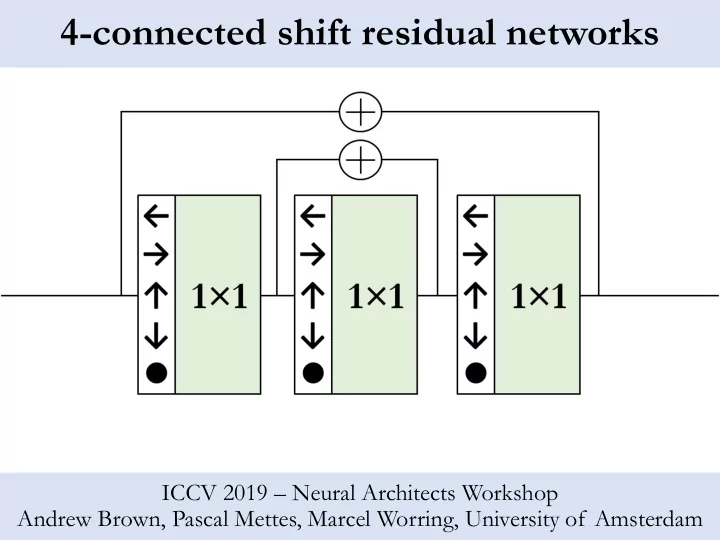

4-connected shift residual networks ICCV 2019 – Neural Architects Workshop Andrew Brown, Pascal Mettes, Marcel Worring, University of Amsterdam
Network costs increasing! • Increasing accuracy on ImageNet has come at increasing cost • Popular metrics: FLOPs and parameters • Can we reduce cost without reducing accuracy?
Shift operation • Shifts – operations move input channels spatially • Different channels move in different directions • Shifts are possible spatial convolution replacements • Spatial conv. → shift + pointwise conv. (i.e. simple matrix multiplication) • Shifts themselves are zero parameter, zero FLOP operations
Do shifts improve network cost? • Shifts have shown improvements to compact networks • Picture not clear for higher FLOP/accuracy networks
Which shift neighbourhood to use? 8-Connected 4-Connected Neighbourhood Neighbourhood • Shifts move inputs – but in which directions? • 8-connected shift: Left, right, up, down and diagonals • 4-connected shift: Left, right, up and down only
Applying shifts to ResNet Operation structure of residual block Receptive field spatial extent of residual block • First expt: replacement of spatial convolutions in ResNet residual blocks • ‘Bottleneck’ residual block design • 3 × 3 spatial convolution → shift + point -wise convolution
Single shift results • Shifts give a large cost reduction • More than 40% in both parameters and FLOPs • Single shift networks gives accuracy penalty BUT • Better than reducing network length
Single shift results: shift comparison • 4-connected shift performs as well as 8-connected on ImageNet
No shift results • No shift networks – only one spatial convolution in very first layer • Accuracy penalty suffered – but surprisingly not so much!
Even more shifts! Operation structure of residual block Receptive field spatial extent of residual block • Add shifts to down- and up- sampling bottleneck convolutions • Idea is to allow larger receptive field within each block
Removing the bottleneck Operation structure of residual block Receptive field spatial extent of residual block • Now the spatial convolutions are gone, why use a bottleneck? • No longer a need to down-sample in each residual block • Flatten the channel structure • Need to reduce length to reduce cost: 101 layers → 35 layers
Multi-shift results: with bottleneck • Multi-shift networks match ResNet in accuracy! • …but only for 4-connected shifts, not 8-connected shifts • Maintains >40% parameters and FLOPs reductions
Multi-shift results: without bottleneck • Multi-shift networks without bottleneck: beats ResNet in accuracy • Again best performance (+0.8%) is for 4-connected shifts
Results in context Multi-shift without bottlenecks (35 layers) Multi-shift with bottlenecks (50 and 100 layers) • Shifts can improve high accuracy CNNs!
Summary • Studied variants of the shift operation • Compare 8- and 4- connected shift neighbourhoods • Modified ResNet bottleneck residual blocks to include shifts • Consider both single and multiple shifts in each block • Multi-4-connected shift variants can improve ResNet • 1 st case: Improve costs by more than 40% at same accuracy • 2 nd case: Improves ImageNet accuracy by +0.8% for ~same costs
Recommend
More recommend